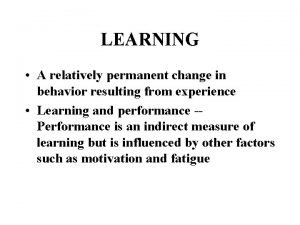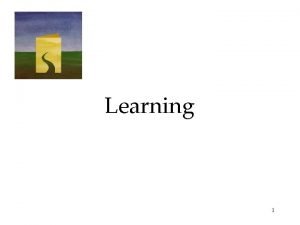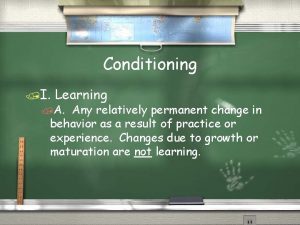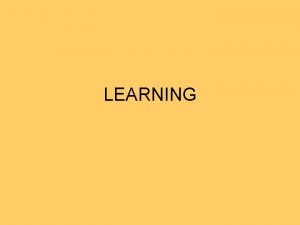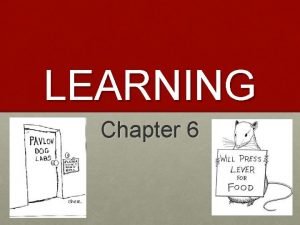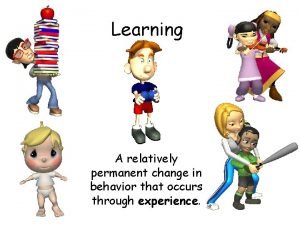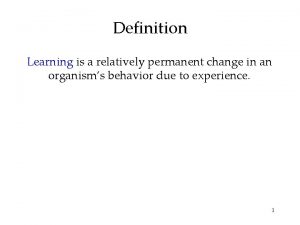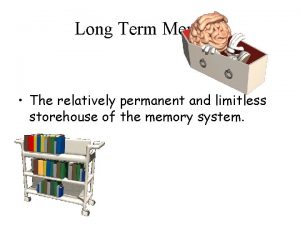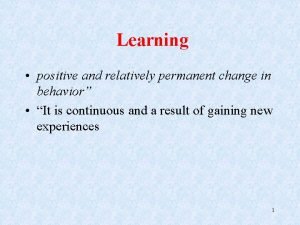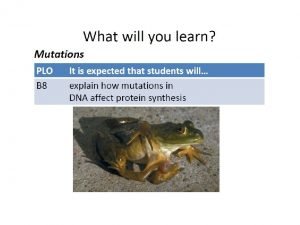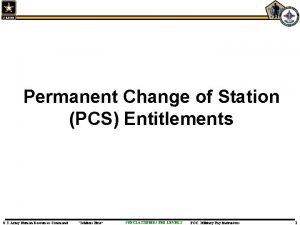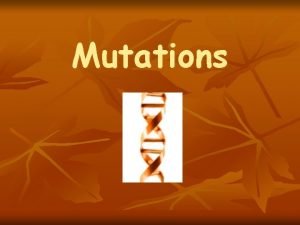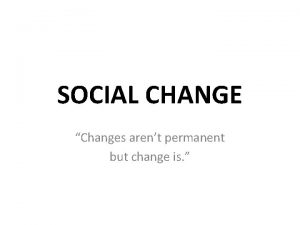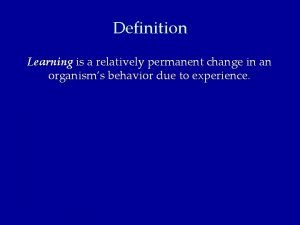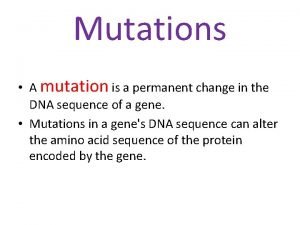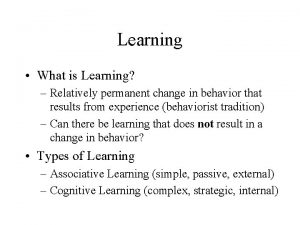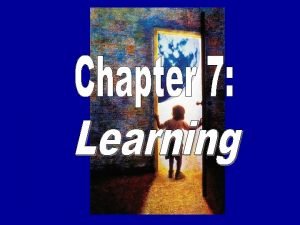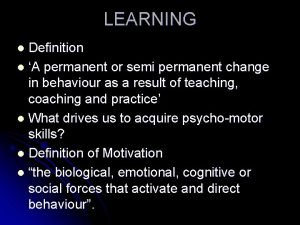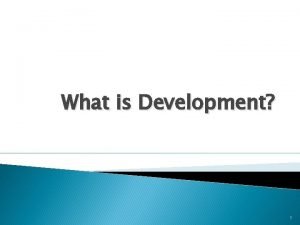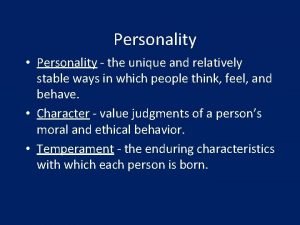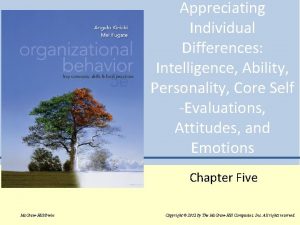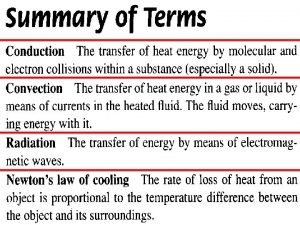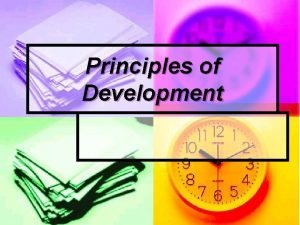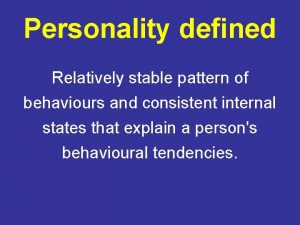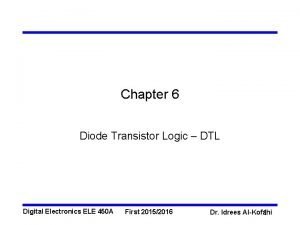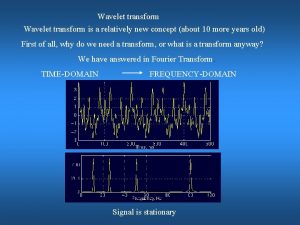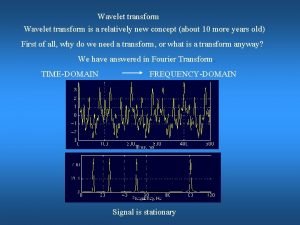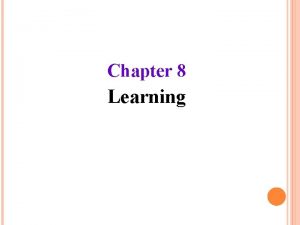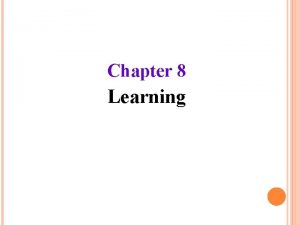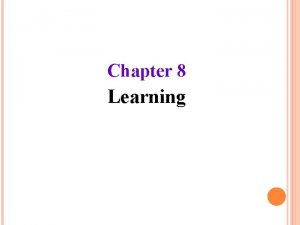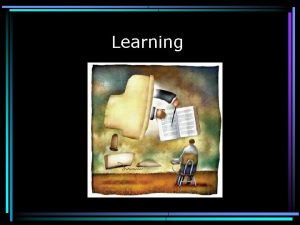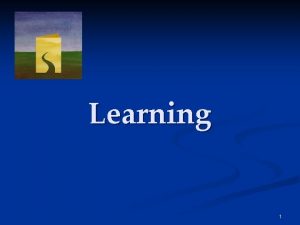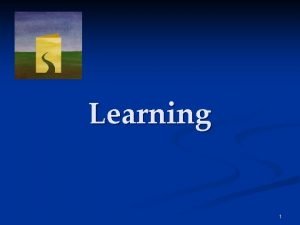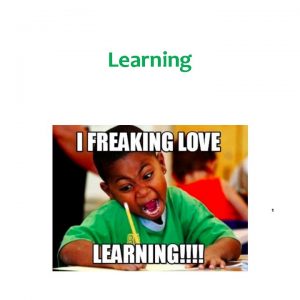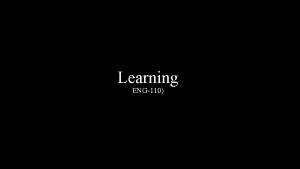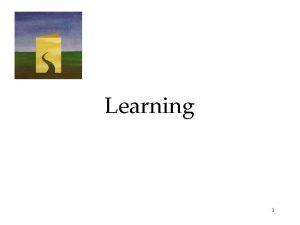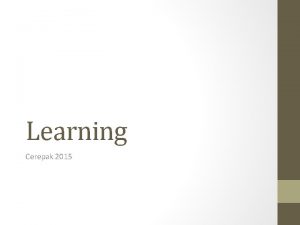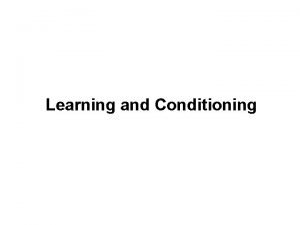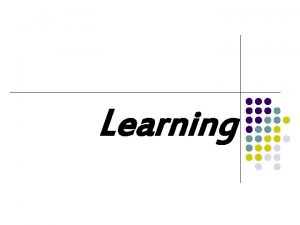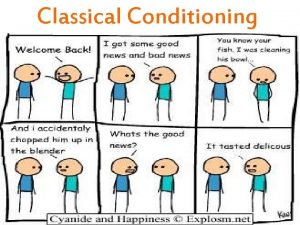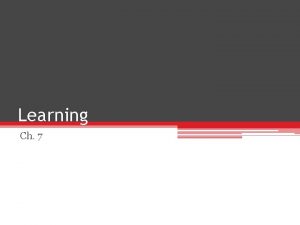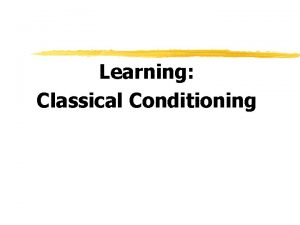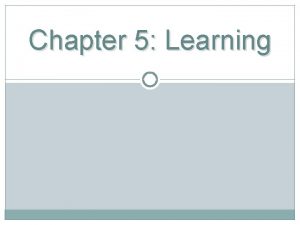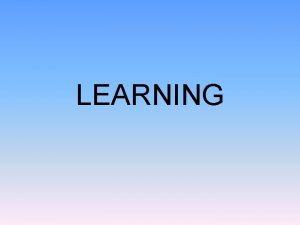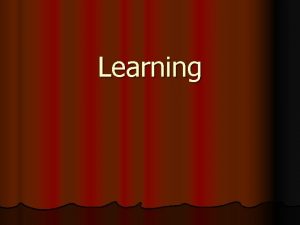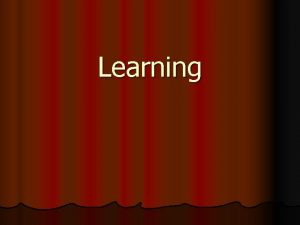Definition Learning is a relatively permanent change in


















































- Slides: 50

Definition Learning is a relatively permanent change in an organism’s behavior due to experience.

Associative Learning to associate one stimulus with another.

Associative Learning to associate a response with a consequence.

Classical Conditioning Russian physiologist Ivan Pavlov elucidated classical conditioning. His work provided a basis for later behaviorists like John Watson. Ivan Pavlov (1849 -1936)

Associative Learning: Classical Conditioning Learning to associate one stimulus with another.

Pavlov’s Experiments Before conditioning, food (Unconditioned Stimulus, US) produces salivation (Unconditioned Response, UR). However, the tone (Neutral Stimulus) does not.

Pavlov’s Experiments During conditioning, the neutral stimulus (tone) and the US (food) are paired, resulting in salivation (UR). After conditioning, the neutral stimulus (now Conditioned Stimulus, CS) elicits salivation (now Conditioned Response, CR)

Acquisition is the initial learning stage in classical conditioning in which an association between a neutral stimulus and an unconditioned stimulus takes place • • For strongest conditioning the NS needs to precede the unconditioned stimulus The time in between the two stimuli should be about half a second

Acquisition The CS needs to come half a second before the US for acquisition to occur.

Stimulus Generalization and Discrimination • Tendency to respond to stimuli similar to the CS is called generalization. Pavlov conditioned the dog’s salivation (CR) to different tones • Discrimination is the ability to distinguish between the conditioned stimulus and other stimuli that do not signal an unconditioned stimulus (different tones)

Extinction When the US (food) does not follow the CS (tone), CR (salivation) begins to decrease and eventually causes extinction. Can occur through Systematic or gradual desensitization

Spontaneous Recovery After a rest period, an extinguished CR (salivation) spontaneously recovers, but if the CS (tone) persists alone, the CR becomes extinct again

Extending Pavlov’s Understanding Pavlov and Watson considered consciousness, or the mind, unfit for the scientific study of psychology. However, they underestimated the importance of cognitive processes and biological constraints

Biological Predispositions Conditioned aste aversions Courtesy of John Garcia showed that the duration between the CS and the US may be long (hours), but yet result in conditioning. A biologically adaptive CS (taste) led to conditioning but other stimuli (sight or sound) did not.

Biological Predispositions Even humans can develop classically to conditioned nausea. Chemotherapy and classical conditioning

Cognitive Processes Early behaviorists believed that learned behaviors of various animals could be reduced to mindless mechanisms However, later behaviorists suggested that animals learn the predictability of a stimulus, meaning they learn expectancy or awareness of a stimulus (Rescorla & Wagner, 1972)

Applications of Classical Conditioning • Former crack cocaine users should avoid cues (people, places) associated with drug use • Through classical conditioning, a drug (plus its taste) that affects the immune response may cause the taste of the drug to invoke the immune response • Exposure therapy (Systematic desensitization) • Aversive Conditioning (Antabuse)

Applications of Classical Conditioning John Watson and the Baby Albert Experiment – What happened? Brown Brothers Watson later used classical conditioning techniques to develop advertising campaigns John B. Watson

Associative Learning: Operant Conditioning Learning to associate a response with a consequence.

Operant & Classical Conditioning 1. Classical conditioning forms associations between stimuli (CS and US). Operant conditioning, on the other hand, forms an association between behaviors and the resulting events.

Operant & Classical Conditioning • Classical conditioning involves respondent behavior that occurs as an automatic response to a certain stimulus • Operant conditioning involves operant behavior, a behavior that operates on the environment, producing rewarding or punishing stimuli

Skinner’s Experiments Skinner’s experiments extend Thorndike’s law of effect. This law states that rewarded behavior is likely to occur again. Yale University Library

Walter Dawn/ Photo Researchers, Inc. From The Essentials of Conditioning and Learning, 3 rd Edition by Michael P. Domjan, 2005. Used with permission by Thomson Learning, Wadsworth Division Operant Chamber Skinner developed the operant chamber, or the Skinner box, to study operant conditioning and the role of reinforcers

Operant Chamber The operant chamber, or Skinner box comes with a bar or key that an animal manipulates to obtain a reinforcer like food or water. The bar or key is connected to devices that record the animal’s response (frequency and rates)

Shaping is the operant conditioning procedure in which reinforcers guide behavior towards the desired target behavior through successive approximations Fred Bavendam/ Peter Arnold, Inc. Khamis Ramadhan/ Panapress/ Getty Images A rat shaped to sniff mines. A manatee shaped to discriminate objects of different shapes, colors and sizes.

Types of Reinforcers Reinforcement = Any event that strengthens the behavior it follows. A heat lamp positively reinforces a meerkat’s behavior in the cold Reuters/ Corbis

Primary & Secondary Reinforcers • Primary Reinforcer: An innately reinforcing stimulus like food or drink • Conditioned Reinforcer: A learned reinforcer that gets its reinforcing power through association with the primary reinforcer (secondary reinforcer = $$)

Immediate & Delayed Reinforcers • Immediate Reinforcer: A reinforcer that occurs instantly after a behavior. A rat gets a food pellet for a bar press • Delayed Reinforcer: A reinforcer that is delayed in time for a certain behavior. A paycheck that comes at the end of a week We may be inclined to engage in small immediate reinforcers (watching TV) rather than large delayed reinforcers (getting an A in a course) which require consistent study

Reinforcement Schedules • Continuous Reinforcement: Reinforces the desired response each time it occurs • Partial Reinforcement: Reinforces a response only part of the time. Though this results in slower acquisition in the beginning, it shows greater resistance to extinction later on

Ratio Schedules • Fixed-ratio schedule: Reinforces a response only after a specified number of responses. e. g. , piecework pay • Variable-ratio schedule: Reinforces a response after an unpredictable number of responses. This is hard to extinguish because of the unpredictability (e. g. , behaviors like gambling, fishing)

Interval Schedules • Fixed-interval schedule: Reinforces a response only after a specified time has elapsed (e. g. , preparing for an exam only when the exam draws close) • Variable-interval schedule: Reinforces a response at unpredictable time intervals, which produces slow, steady responses (e. g. , pop quiz)

Schedules of Reinforcement

Punishment An aversive event that decreases the behavior it follows

Punishment Although there may be some justification for occasional punishment (Larzelaere & Baumrind, 2002), it usually leads to negative effects. 1. 2. 3. 4. Results in unwanted fears. Conveys no information to the organism. Justifies pain to others. Causes unwanted behaviors to reappear in its absence. 5. Causes aggression towards the agent.

Intrinsic Motivation: The desire to perform a behavior for its own sake. Extrinsic Motivation The desire to perform a behavior due to promised rewards or threats of punishments.

Biological Predisposition Biological constraints predispose organisms to learn associations that are naturally adaptive. Breland (1961) showed that animals drift towards their biologically predisposed instinctive behaviors (biological or instinctual drift)

Applications of Operant Conditioning • Reinforcing good behavior increases the occurrence of these behaviors. Ignoring unwanted behavior decreases their occurrence • Skinner introduced the concept of teaching machines to shape learning in small steps. Related notion of token economy • Reinforcers affect productivity. Many companies now offer incentives to employees

Operant vs. Classical Conditioning

Skinner’s Legacy Skinner argued that behaviors were shaped by external influences instead of inner thoughts and feelings (the perspective known as Behaviorism). Critics argued that Skinner dehumanized people by neglecting their free will.

Cognitive Learning • Evidence of cognitive processes during operant learning comes from rats during a maze exploration in which they navigate the maze without an obvious reward (Tolman’s Rat maze experiments) • Rats seem to develop cognitive maps, or mental representations, of the layout of the maze (environment). Related concept of latent learning

Latent Learning Such cognitive maps are based on latent learning, which becomes apparent only when an incentive is given (Tolman & Honzik, 1930).

Learned Helplessness • Martin Seligman’s experiments • Provide a definition • Human model for depression. Explain

Observational Learning © Herb Terrace Higher animals, especially humans, learn through observing and imitating others Imitative learning and modelling ©Herb Terrace

Reprinted with permission from the American Association for the Advancement of Science, Subiaul et al. , Science 305: 407 -410 (2004) © 2004 AAAS. Mirror Neurons • Neuroscientists discovered mirror neurons in the brains of animals and humans that are active during observational learning.

Learning by observation begins early in life. This 14 -month-old child imitates the adult on TV in pulling a toy apart. Meltzoff, A. N. (1998). Imitation of televised models by infants. Child Development, 59 1221 -1229. Photos Courtesy of A. N. Meltzoff and M. Hanuk. Imitation Onset

Bandura's Bobo doll study (1961) indicated that individuals (children) learn through imitating others who receive rewards and punishments Vicarious learning Courtesy of Albert Bandura, Stanford University Bandura's Experiments

Applications of Observational Learning Unfortunately, Bandura’s studies show that antisocial models (family, neighborhood or TV) may have antisocial effects

Positive Observational Learning Bob Daemmrich/ The Image Works Fortunately, prosocial (positive, helpful) models may have prosocial effects

Gentile et al. , (2004) shows that children in elementary school who are exposed to violent television, videos, and video games express increased aggression Ron Chapple/ Taxi/ Getty Images Television and Observational Learning

Modeling Violence Children modeling after pro wrestlers Glassman/ The Image Works Bob Daemmrich/ The Image Works Research shows that viewing media violence leads to an increased expression of aggression
 Relatively permanent change
Relatively permanent change Relatively permanent meaning in english
Relatively permanent meaning in english Learning is permanent
Learning is permanent Is any relatively permanent change in behavior
Is any relatively permanent change in behavior Relatively permanent definition
Relatively permanent definition Douglas merritte
Douglas merritte A relatively permanent change of behavior is called
A relatively permanent change of behavior is called A relatively permanent change of behavior is called
A relatively permanent change of behavior is called The relatively permanent and limitless storehouse
The relatively permanent and limitless storehouse Relatively permanent
Relatively permanent Define as permanent change in dna.
Define as permanent change in dna. Cuadro comparativo e-learning m-learning b-learning
Cuadro comparativo e-learning m-learning b-learning Jtr 0506
Jtr 0506 What is a helpful mutation
What is a helpful mutation Changes aren't permanent but change is
Changes aren't permanent but change is Define permanent change
Define permanent change Permanent change in dna sequence
Permanent change in dna sequence Learning is permanent
Learning is permanent Shaping psychology definition
Shaping psychology definition Semi-permanent definition
Semi-permanent definition Painting the wall physical change or chemical change
Painting the wall physical change or chemical change What is physical change
What is physical change Absolute change and relative change formula
Absolute change and relative change formula What is integers in maths
What is integers in maths Whats the difference between a chemical and physical change
Whats the difference between a chemical and physical change Decrease in supply vs decrease in quantity supplied
Decrease in supply vs decrease in quantity supplied Change in supply and change in quantity supplied
Change in supply and change in quantity supplied Enagic compensation plan
Enagic compensation plan Proactive and reactive change
Proactive and reactive change Chemical change and physical change
Chemical change and physical change Spare change physical versus chemical change
Spare change physical versus chemical change Rocks change due to temperature and pressure change
Rocks change due to temperature and pressure change Whats physical change
Whats physical change How does a physical change differ from a chemical change
How does a physical change differ from a chemical change Study jams physical and chemical changes
Study jams physical and chemical changes First and second order change in education
First and second order change in education Chopping wood physical or chemical
Chopping wood physical or chemical Climate change 2014 mitigation of climate change
Climate change 2014 mitigation of climate change Orderly and concise personality
Orderly and concise personality Definition of remedial teaching
Definition of remedial teaching Anal stage psychology definition
Anal stage psychology definition Are complex relatively brief responses
Are complex relatively brief responses Objects that radiate relatively well
Objects that radiate relatively well Floors should be relatively smooth and non-absorbent.
Floors should be relatively smooth and non-absorbent. Principles of developmentally appropriate practice
Principles of developmentally appropriate practice It refers to the stable pattern or configuration
It refers to the stable pattern or configuration The maintenance of a stable internal environment
The maintenance of a stable internal environment Gas particles are separated by relatively large distances
Gas particles are separated by relatively large distances Modified dtl gates
Modified dtl gates Relatively new concept
Relatively new concept Relatively new concept
Relatively new concept
